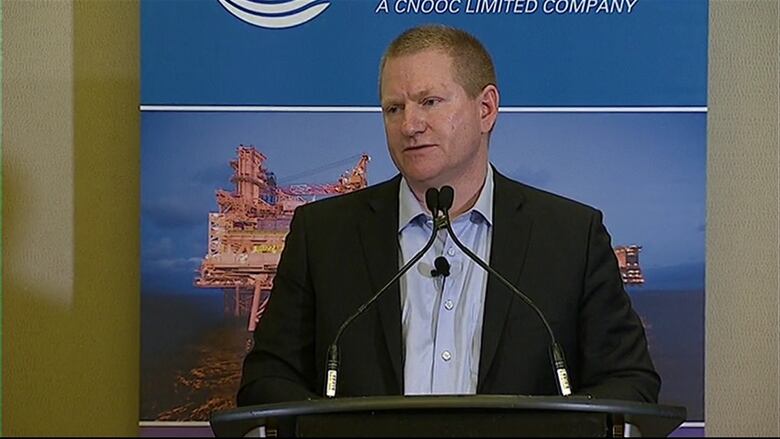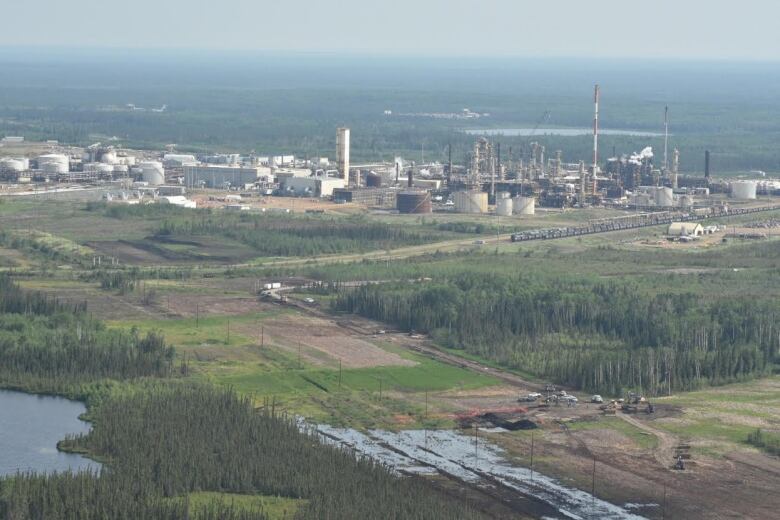Nexen apologizes for northern Alberta pipeline break
'We are deeply concerned with this,' executive says after major spill
Nexen is apologizing fora pipeline break that leaked five million litres of bitumen,sand and water at its Long Lake oilsands facilityin northern Alberta this week.
"We are deeply concerned with this," said Ron Bailey, Nexen'sseniorvice-president of Canadian operations. "We sincerely apologize for the impact this had caused."
The spill was discovered Wednesday afternoon atNexenEnergy'soilsandsfacility near Long Lake, south of FortMcMurray.
- Nexen pipeline leak in Alberta spills 5 million litres
- Plains Midstream fined $1.3M after guilty plea
- Alberta pipelines: 6 major oil spills in recent history
The material leaked through what Bailey says was a"visible burst" in the pipeline. a double-walled, high-pressureline installed in 2014. Bailey said the line was shut down immediately after the leak was discovered.
The detection system did not work in this case, so it isn't known how long the substancewas leaking. A contractor walking along the pipeline discovered the spill.

"This is a modern pipeline," Baileysaid. "We have pipeline integrity equipment, some very good equipment," he said. "Our investigation is looking through exactly why that wasn't alerting us earlier."
The spill covers an area of about 16,000 square metres. Bailey said it is mostlycontained within the pipeline right of way.
The area can only be reached by a winter access road, so the company had to build a road into the site. Bailey said the vacuuming of theoil isstarting today. The site is contained by berms and other abatement equipment.
Bailey declined to name the company that manufactured the pipeline.
Despite the scope of the incident,Alberta Premier RachelNotleysaid pipelines are still the best way to transport oil and gas.
"For instance, in Quebec, they know full well that rail is much more problematic a transportation method," Notley toldCBC'sEdmonton AMon Friday.
"Even within this unfortunate accident, which I'm troubled by."

She said her government is getting regular updates about the spill.
"We'll be doing an investigation into what went wrong and what happened with respect to how long the leak was in place and whether everything was done to catch it as soon as it could be, as well as to prevent it at the outset," she said.
"Unfortunately, there's nothing we can say except that we are going to learn from this."
A spokesman fortheAthabasca Chipewyan First Nation said a spill this big will have an"extremely serious" impact on the muskeg, which is home to aboriginalmedicines, berries and wild game.
"There is no way to clean or reclaim the muskeg," saidErielDerangerin a news release Friday. "Destruction and contamination like this that directly affects akey component of our ecosystems is affecting First Nations' ability to access lands and territories for hunting, fishing, gathering and trapping rights, rights protected by both the Constitution and our treaties."
Chief Allan Adamsaidthe spill is "dangerously close" to the Clearwater River, whichflows directly into the Athabasca River.
"The repercussions from the incident could potentially be felt far and wide by those that rely on the Athabasca basin," he said.
In April 2011, a Plains Midstream Canada ULC pipeline leaked 4.5 million litres of crude oil near a First Nations community in northwest Alberta.
That leak was the largest in the province in 35 years. It contaminated more than three hectares of beaver ponds and muskeg in a densely forested area.















_(720p).jpg)


 OFFICIAL HD MUSIC VIDEO.jpg)
.jpg)



























































































